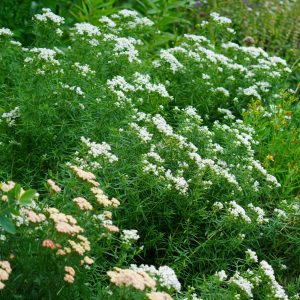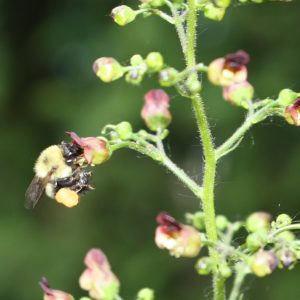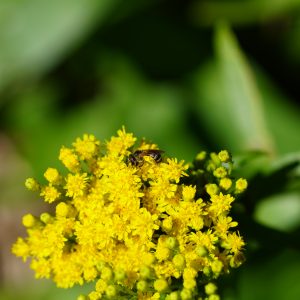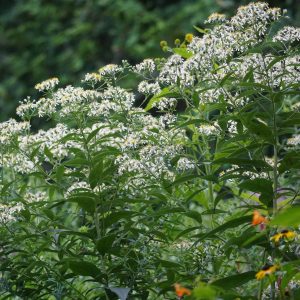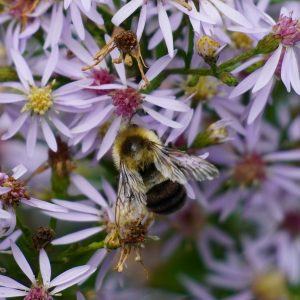by Berit Erickson
For Pollinator Appreciation Day this year, we raffled some of our native plant favourites. Here are the species we gave away.
Serviceberry (Amelanchier alnifolia)
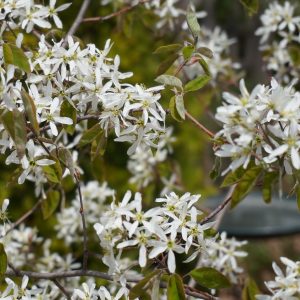
Serviceberries are one of the earlier-blooming native shrubs/small trees. In early May they are covered in white flowers and solitary bees. By mid-June ripe Serviceberry fruits are eaten by a variety of birds, particularly Robins and Cedar Waxwings – and by people too. In the fall, the leaves turn a lovely apricot colour.
Serviceberries may be afflicted with Cedar-Apple Rust when there are Junipers nearby. With my shrubs, rust may damage some leaves and fruit, but it doesn’t seem to seriously affect the plants. Some years are worse than others.
Red Osier Dogwood (Cornus sericea)
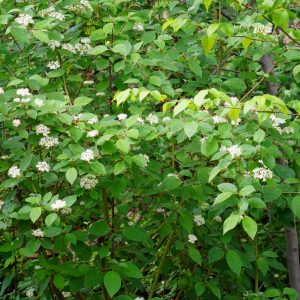
Red Osier Dogwoods are my favourite shrubs because they’re attractive all year ‘round. In spring, they’re covered in clusters of white flowers, in summer the flowers turn into bunches of white berries, they have burgundy leaves in fall that contrast nicely with nearby bright leaves and fall flowers, and in winter their stems turn bright red.
These shrubs also have high wildlife value. They’re host plants for some butterfly species, provide food for pollinators, and offer nutritious berries to migrating birds. Red Osier Dogwoods also bloom repeatedly throughout the summer, so they keep providing nectar and pollen for insects, and berries for birds.
Each year, I cut ⅓ of the stems back to the ground to maintain a tight, tidy shape. Another reason to cut back is that new stems are brighter red. I end up with more attractive winter stems, a smaller shrub, without sacrificing flowers and berries.
Swamp Milkweed (Asclepias incarnata)
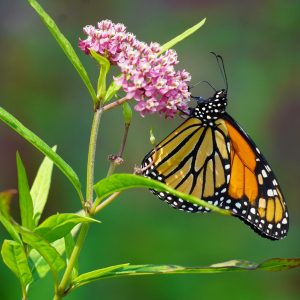
Swamp Milkweed is my favourite milkweed species. It is a well-behaved, clumping plant – unlike it’s common cousin – and has showy, pink flowers in mid-summer. Despite its name, Swamp Milkweed is quite adaptable, growing well in my garden’s drier conditions, and in sun and part shade.
Swamp Milkweed is a preferred host plant for Monarch butterflies because it has thin, tender leaves for caterpillars to eat. The pretty flowers are visited by various bees, wasps, butterflies and hummingbirds.
Virginia Mountain Mint (Pycnanthemum virginianum)
Native mints are particularly beneficial to pollinators. In summer Virginia Mountain Mint is covered in flat clusters of tiny white flowers that attract lots of bees, butterflies and other insects.
In my dry, sunny boulevard garden, Mountain mint grows to about 2 feet tall. It’s a nice, bushy filler plant even when it isn’t in bloom. It grows in a variety of soils, and will even tolerate some shade, though it may get floppy. My 7-year old plants have formed a nice patch, but they haven’t spread aggressively.
Figwort (Scrophularia lanceolata)
Figwort may not be the showiest plant, but it’s a nectar powerhouse. It’s diminutive burgundy flowers are like tiny buckets of nectar attracting lots of insect pollinators, as well as hummingbirds.
At about 5 feet tall, it’s a good back-of-the-border plant. It is easy to care for, and will even tolerate dry, part-shade. I do find that the foliage has an unpleasant, toasted or smokey smell.
Foxtail Sedge (Carex alopecoidea)
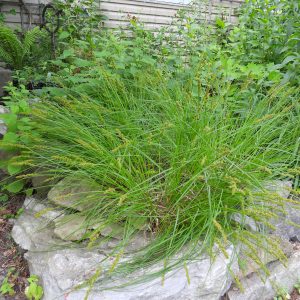 While I want to pack as many flowers into my garden as possible, I always find room to tuck in some sedges. Foxtail sedge is a good choice because it tolerates a range of soil and light conditions. This sedge forms tidy tufts of delicate, arching leaves. They add lovely texture that contrasts with bold foliage and flowers.
While I want to pack as many flowers into my garden as possible, I always find room to tuck in some sedges. Foxtail sedge is a good choice because it tolerates a range of soil and light conditions. This sedge forms tidy tufts of delicate, arching leaves. They add lovely texture that contrasts with bold foliage and flowers.
I like dotting them here and there beneath taller plants, shading the soil. Surprisingly, sedges are host plants for small skipper butterflies. They also provide shelter for birds, and birds will hop up to eat the seeds.
Ohio Goldenrod (Solidago ohioensis)
With flat clusters of flowers, Ohio Goldenrod is an early blooming goldenrod that doesn’t look like a goldenrod. Like its relatives, it attracts non-stop pollinator activity from a range of insect species. Plants are about 3 feet tall. While it prefers moist conditions, it grows just fine in my dry clay soil.
Flat-topped Aster (Doellingeria umbellata)
I’ve been growing Flat-topped Aster for several years now. It’s become one of my favourite plants because it’s long-blooming and very tough. I have some plants in part-shade, and others in sun, and both locations tend to be dry.
In late August and September, each sturdy 6-foot stem is covered in large umbels of white flowers. Pollinators enjoy Flat-topped Aster as much as I do. There’s continual insect activity at the flowers, and I’ve spotted quite a variety of species.
Although Flat-topped Aster isn’t as showy as some of its colourful and later blooming relatives, it’s worth adding to the back of your border. It combines well with other tall natives, like Yellow Giant Hyssop, Field Thistle, Ironweed and Wingstem.
Heart-leaved Aster (Symphyotrichum cordifolium)
Heart-leaved Asters are a delightful addition to pollinator gardens. In September, they produce clouds of dainty, pale bluish-purple flowers on 3-foot stems. I primarily see bumble bees and Bi-colored Green Sweat bees visiting the flowers.
Despite its delicate appearance, this plant is tough. It seems to grow anywhere, and is doing well even in my partly shady garden in dry, clay soil. In moist, loamy soil it can be a nuisance, spreading by rhizomes and by seed.
During fall migration, I’ve seen warblers and kinglets foraging for insects on plants near our dining room window. I’ve also seen birds eating the seeds.
